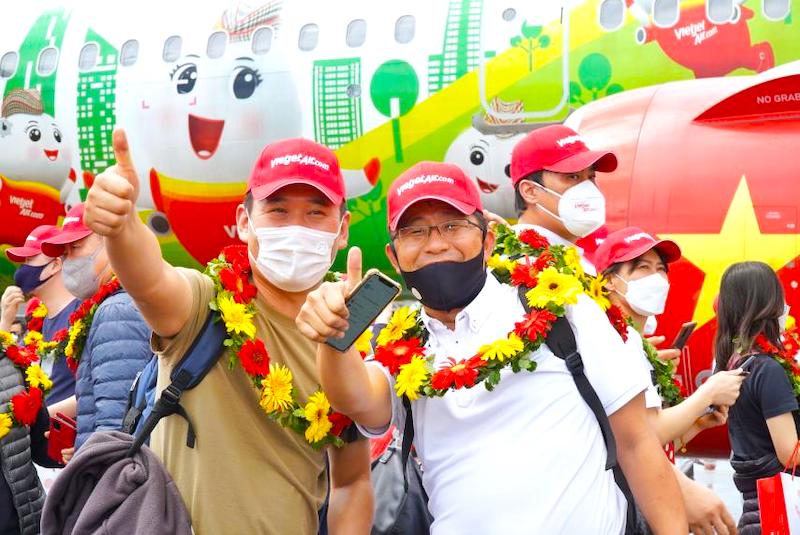There is a palpable sense of optimism among the Vietnamese population as they eagerly look forward to upcoming travel opportunities in the months ahead. This wave of anticipation represents a ray of hope for the gradual revival and restoration of the nation’s vital tourism sector.
| First foreign visitors to Phu Quoc Island, Khanh Hoa Province under the pilot program. Photo: Vietjet Air |
According to the latest report conducted by the Tourism Advisory Board (TAB), the findings on tourist demand and trends in Vietnam during the Covid-19 period reveal that approximately 90% of respondents express a desire to travel within the next 10 months. Interestingly, 27% of these individuals are willing to embark on their travels as early as the beginning of 2022.
The recent data from the TAB Secretariat, as presented by Hoang Nhan Chinh, demonstrates increasing demand for travel among tourists. It highlights the eagerness of people to embark on sightseeing ventures after prolonged periods of Covid-19 restrictions.
With the reopening of international air routes to certain countries and territories starting on January 1, there is anticipation for a surge in international visitors during the second phase of the tourism pilot program.
According to the latest data from the Vietnam National Administration of Tourism (VNAT), Phu Quoc Island (Kien Giang), Khanh Hoa, and Quang Nam have successfully received over 8,500 international tourists with vaccine passports from various countries such as Russia, Uzbekistan, Kazakhstan, South Korea, Singapore, the UK, US, and Canada. This milestone has been achieved after a two-month trial period of welcoming international tourists.
According to the Vietnam National Administration of Tourism (VNAT), Vietnam has demonstrated itself as a secure and appealing tourist destination, showcasing the adaptability and flexibility of the Vietnamese tourism industry.
The Ministry of Culture, Sports and Tourism has submitted a comprehensive roadmap to the Government for the complete resumption of international tourism. Under this plan, the current pilot phase will continue until April 30, leading to the full reopening of international travel, both inbound and outbound, starting from May 1. This represents a significant step towards embracing the “new normal” in the tourism industry.
Airlines, travel agencies, and hotels are eagerly awaiting the government’s announcement regarding the resumption of tourism activities in February. During a conference on January 26, Trinh Hong Quang, the Deputy General Director of Vietnam Airlines, proposed reopening tourism from February 1st, citing positive growth in the domestic market.
Several air carriers, including Vietnam Airlines, Vietjet Air, and Bamboo Airways, along with tour operators and hospitality businesses such as VietravelSaigontourist, Sun Group, and Thien Minh Group, are eagerly awaiting the announcement of the reopening date. They hope to start preparing promotional campaigns once the date is confirmed. This sentiment is also echoed by the Research and Development Board of the Prime Minister’s Advisory Council for Administrative Procedure Reform.
Local businesses believe that the upcoming event presents a unique opportunity for the tourism industry to make significant progress, as well as attract foreign investment and boost international trade flows.
Vu The Binh, the Standing Vice Chairman of the Vietnam Tourism Association, has proposed an effective strategy to entice international tourists. In order to attract more travelers, Binh recommends implementing a visa exemption policy, alongside mandatory negative nCoV test results within 72 hours prior to departure. This approach aims to ensure the safety and well-being of visitors, while also promoting the country’s tourism industry.
“The Ministry of Health is urged to promptly issue comprehensive regulations regarding isolation for the benefit of tourists’ awareness,” he emphasized.
According to the latest statistics, in 2019, Vietnam experienced a significant boost in tourism. The country received an impressive 18 million international visitors, marking a remarkable 16.2% increase from the previous year. Additionally, there was a notable rise of 6% in the number of domestic tourists, reaching a total of 85 million. This influx of visitors contributed to a substantial tourism revenue exceeding US$31.2 billion. These figures highlight the thriving tourism industry in Vietnam.
Hanoi’s Tourism Plan
| St. Joseph’s Cathedral is one of the favorite destinations for tourists. HNT Photo: Duy Khanh |
The Hanoi Department of Tourism has formulated a comprehensive tourism recovery plan for the year 2022, despite not being included in the pilot program for receiving international tourists in Vietnam.
According to Dang Huong Giang, the Director of the Hanoi Department of Tourism, the local travel industry has been actively developing new products to enhance the visitor experience. Additionally, the department is planning to organize and promote various events, including festivals celebrating Ao Dai (traditional Vietnamese clothing), food, and gifts.
The city is aiming to attract 10-12 million visitors next year, including 1.2-2 million international tourists, with a strong emphasis on prioritizing tourism safety.
In 2021, Hanoi’s tourism industry continued to confront challenges in the wake of the global pandemic. The number of visitors to the capital city was estimated at four million, representing a decrease of 53% compared to the previous year.
The majority of international arrivals are comprised of diplomats, business executives, and highly skilled laborers. They are traveling with their families and have been granted authorization by the government, following the implementation of the border closure in March 2020.
The estimated total revenue from tourists in Hanoi reached VND11.28 trillion ($495.6 million), accounting for 42% of the earnings from 2020. Hanoi currently has a total of 3,722 active accommodation establishments with 69,954 rooms. It is worth mentioning that 20 hotels were temporarily converted into medical isolation facilities to support the prevention and control of Covid-19.
According to recent data, approximately 1,550 accommodation establishments have temporarily suspended operations or transitioned to different industries. Furthermore, the average occupancy rate of hotels across all categories has been evaluated at 23%, representing a 7% decrease compared to the previous year.






